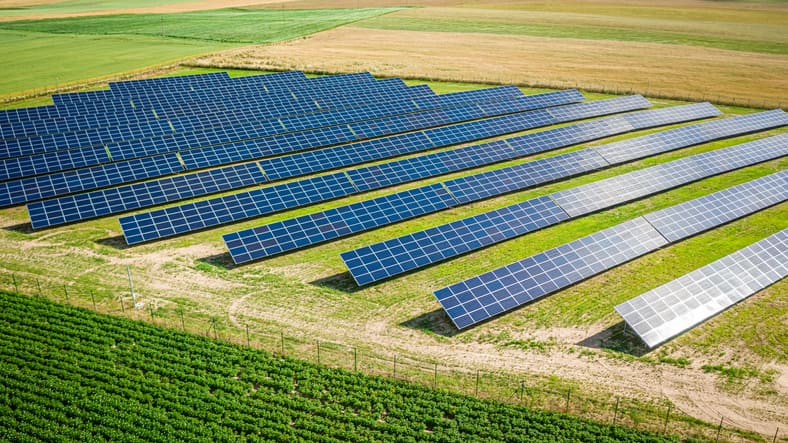
When we harness the power of the sun, we begin to break away from our dependency on dangerous, finite fossil-fuel-based energy sources. Active and passive solar energy are both clean, renewable forms of energy capable of making a meaningful difference in our world. While both are produced by capturing sunlight, there are distinct differences in how active and passive solar energy is utilized.
What is Active Solar Energy?
Active solar energy is a dynamic and technology-driven approach to harnessing the sun’s power for various applications. It uses mechanical or electrical systems to capture, convert, and distribute solar energy actively. The primary focus of active solar energy is often on electricity generation through technologies such as solar photovoltaic (PV) systems. These systems consist of solar panels that directly convert sunlight into electrical power, offering a sustainable and renewable source of energy for homes, businesses, and communities. A great example of active solar energy is a community solar farm. With community solar, participants can access clean, renewable energy at lower costs than traditional fossil-fuel-powered electricity.
What is Passive Solar Energy?
Passive solar energy represents a natural and architecture-centric approach to harnessing the sun’s energy for practical applications. While active solar systems rely on technology, passive solar energy utilizes the inherent properties of building materials and design to collect, store, and distribute sunlight. It’s a sustainable strategy that minimizes the need for mechanical or electrical components. In passive solar design, buildings are oriented to optimize exposure to the sun, incorporating features such as large south-facing windows, thermal mass, and overhangs. These elements work harmoniously to passively capture and retain solar heat during the day and release it gradually at night. Passive solar energy is employed for various purposes, including space heating, natural lighting, and ventilation.
Key Differences Between Passive vs Active Solar Energy
Passive and active solar energy represent two distinct approaches to harnessing solar power, each with its unique characteristics, applications, and benefits. Here are six key differences:
Technology vs. Natural Design
The clearest distinction between passive and active solar is their methodologies. Active solar is centered on technology and mechanical systems like solar arrays to promote the use of solar energy. Passive solar relies solely on the natural designs of buildings and features like orientation, windows, and thermal mass to collect and distribute solar heat.
Applications
Active solar utilizes technologies like solar panels to generate electricity. Whether consumers want to turn on lights in their homes, charge their electric vehicle (EV), or run electric-powered household appliances, active solar will allow them to do so. Of course, active solar can also be applied to solar water heating systems and other technologies. Passive systems rely on natural processes such as conduction, convection, and radiation to distribute captured solar heat throughout the building. Passive solar is applied mainly for space heating, natural lighting, and passive cooling in buildings. It’s able to accomplish this by optimizing a building’s design features like window placements.
Complexity and Components
With active solar, sophisticated and complex components like solar panels, inverters, and batteries are needed to convert sunlight into electricity. Passive solar has minimal reliance on technology. For example, placing windows in areas of a building where it can be exposed to the most sunlight possible will provide solar heat naturally.
Upfront Costs
For homeowners and businesses who wish to install solar equipment on their roofs or properties, there can be upfront costs associated with solar panels, installation, and interconnecting solar to the on-premises electrical system. However, with community solar there are no upfront costs. Participants simply sign up for clean, renewable solar energy with their utility company. All solar equipment is located off-site! With passive solar, there are low upfront costs because it simply relies on natural features and materials.
Energy Storage
Active solar can integrate energy storage solutions, such as lithium-ion, iron-based, or zinc-based batteries, to access energy for later use. With passive solar, users can only access the immediate use of solar energy or the gradual release from thermal mass. Passive solar does not have long-term storage capabilities.
Flexibility and Retrofitting
Active solar technology solutions allow for versatility. Solar equipment can be retrofitted into existing structures, offering flexibility. Passive solar can be very challenging to incorporate into existing structures. The best time to integrate passive solar is during the initial design and construction phases.
Choosing Between Active vs Passive Solar Energy
Whether you utilize active vs passive solar energy will depend on your needs and goals. If your primary interest is heating your home, passive solar may be a good choice. However, active solar has a wide range of applications for users. Besides heating your home, sunlight harnessed by solar panels can provide you with electricity to power countless elements of your home, such as kitchen appliances, lights, and much more. Solar farms produce active solar energy for consumption by anyone with a utility account!
If you’re interested in fighting climate change, reducing dependency on fossil-fuel-based electricity, and saving money on your utility bill, U.S. Light Energy can help. We are a distributed generation energy development company specializing in Community Solar facilities and renewable energy solutions for residential, small commercial, and municipal customers. By subscribing to community solar, you can save as much as 10% on your utility bill without spending a cent installing solar equipment on your property. Contact our solar professionals today to learn more about community solar in your area. U.S. Light Energy is leading the charge for a new generation.
